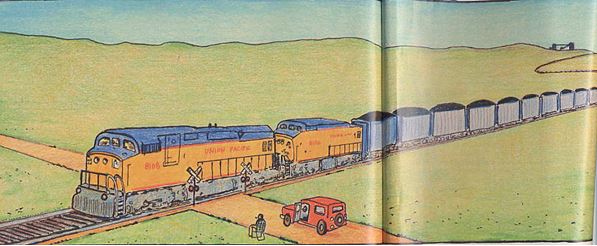Coal for Electric Power Production in the USA
Michel LUNG
This is a summary of two articles by John McPhee published in the issues of 5 and 10 October 2005 of the New Yorker, dealing with a little known aspect of the demands on coal transport for the production of electric power in the United States. In the second part of this text, we will consider some of the environmental and economic issues related to this use of coal.
The “Clean Air Act” of 1970 requires that American industry reduce the sulfur content of gases released to the atmosphere by large facilities, in particular by coal-burning electric power plants. Many power plants had been built near coal beds whose sulfur content is now considered unacceptable. Thus, either the power plants had to be fitted with expensive and cumbersome devices to capture the SO2 in the smoke before it is released to the atmosphere or they had to burn coal with low sulfur content such as that found in the huge coal beds of northern Wyoming.
As an example, the coal in Pennsylvania has very high calorific power and it lies in two meter thick layers but its sulfur content is large while in Wyoming, in the “Fort Union Formation, Powder River Basin”, the layers are 30 meters thick, they lie 30 meters below ground, the coal has five times less sulfur but 30 % less calorific power.
Thus, for the past 20 years, the power plants have been burning coal from the Powder River Basin in Wyoming with its Orin Line, a short three track railroad with multiple ramifications which handles 23 000 coal trains per year. It is the world’s largest coal extraction facility. Today, the excavations are 60 meters deep and 3 to 5 km long. The mine can be worked over the next 50 years at the present depth with no problem and the reserves are estimated at 200 years at the present extraction rate.
Everyday, 65 coal trains carrying 15 000 to 21 000 metric tons of coal (their total end to end length would reach 160 km) leave the mine-head which accommodates several facilities. A typical train comprises 135 aluminum hopper cars, each containing 120 metric tons of ore. Its weight is approximately 2 700 metric tons when empty and 18 000 metric tons when loaded. It is 2 700 meters long (beware at railroad crossings!). These trains are pulled by 3 to 5 diesel-electric (usually alternating current) engines with 13 000 horse-power each. They are placed at the head, in the middle and at the end of the train, they are interconnected electronically and communicate with the track and with the traffic regulating centers which are often far away.
The conveying crews usually comprise a fireman and a mechanic. Each crew covers a portion of the journey, always the same one, and works 12 hours, not a minute longer. Since unpredictable events always occur, the train often stops in the middle of nowhere so that a pickup service has to bring in the new crew and bring back the crew coming off duty. In poor weather conditions, e.g. snow storms, this is not a minor undertaking. A head wind can slow a train down by up to 20 km/h in spite of the powerful engines.
The author takes us to Plant Scherer in Georgia on a 17 000 metric ton train. Plant Scherer is the largest coal fueled power plant in the USA, it belongs to “Georgia Power”. The power plant has 4 in-line turbo generators extending over 450 meters for a total power output approaching 3 000 MW. Under normal conditions, the nearly 3 000 km long journey is accomplished within 5 days. If the trip lasts more than an agreed amount of time, the Norfolk Southern Line has to pay Georgia Power a compensation. A daily average of three and a half trains make the journey from Wyoming; this means an annual 1300 trains with 11 million metric tons of coal conveyed per year.
Train loading and unloading at each end of the line produces enormous amounts of coal-dust which is normally pulled down by means of water spraying, except in freezing weather. As a matter of fact, coal-dust accumulation is liable to make a train derail. At Plant Scherer, the train travels along a wide 2 km diameter loop. At the center of the loop there is a 1 million metric ton buffer coal reserve. The train moves at 5 km/h above hoppers and, within 3 to 4 seconds, each car is emptied from the bottom, which opens up. In the most favorable conditions, the train is emptied within ½ hour. If train unloading takes more than 4 hours, Georgia Power has to pay a compensation to the carrier. The coal is crushed, pulverized and burned at a temperature not exceeding 1650° C to avoid the formation of nitrogen oxides, NOx.
The contents of a « typical » train is burned in less than 8 hours. Information is not provided on what is done with the solid ashes, nor toxic aerosols, nor on how much radon is released during the process.
The author interviews Damon Woodson, a mechanical engineer who has worked in nuclear power in the past and who says that “he had to come here to understand the usefulness of nuclear energy. A single truck of uranium ore can produce as much energy as this one million metric ton pile of coal. The way to go is nuclear if you want to have power.” He goes on to quote the following costs for the production of one million BTUs (British thermal units, 1BTU=1055 Joules=0,293 W-h) of heat.
-
With oil : $ 9
-
With gas : $ 6
-
With coal : $ 1.85
-
With nuclear : $ 0.5
Undoubtedly, this story will have an impact on the readers of the New Yorker who are numerous worldwide.
Moral of the Story
An attempt at drawing some environmental and economic conclusions from this story told in very lively terms is worthwhile.
In the US, 52 % of the electricity is produced in 500 coal-fueled power plants.
Because of environmental considerations, producers of electricity are fetching from afar an approximate 400 million metric tons of lower quality lower sulfur content coal, in spite of the additional conveying cost.
Wyoming coal alone represents almost half of the approximately 900 million metric tons of coal consumed in America. This consumption rejects an estimated 1.9 billion metric tons of CO2 (i.e. 8 % of the 25 billion metric tons of CO2 released to the atmosphere worldwide), 5 to 7 million metric tons of SO2 and 1.6 million metric tons of NOx. Replacing the coal by natural gas would almost halve these amounts but such a conversion to gas-fueled plants is becoming unlikely today because of costs.
In the USA, the price of natural gas was $2 per million BTU in 2002, while it is $6 today. The costs quoted by the author of the article include only the fuel costs, they do not take into account the operation nor the amortization costs. Converting the above costs to dollars per electric MWh produced with the various fuels and assuming today’s best thermodynamic efficiencies (and this is not the case with a number of older power plants in the USA), i.e. 55 % for oil and natural gas, 50 % for coal and 35 % for nuclear fission, one obtains:
-
Oil: $ 55.8/MWhe
-
Gas: $ 37.2/MWhe
-
Coal: $ 12.6/MWhe
-
Nuclear: $ 4.9/MWhe
If the total costs are considered, the following approximate values are obtained, for the United States, in $/MWhe:
As shown in the table, the cost of nuclear power is close to that of coal power and, if servitudes such as ash removal, CO2 capture & storage or probable future taxes on carbon emissions are taken into account, nuclear power will end up less expensive. This holds true even if the price of uranium increases somewhat since its impact on the cost of a KWhe produced is very small (5 to 10 %).
For long distance transportation such as the one that brings the coal to Plant Scherer, the cost of the fuel used to pull the trains in the round trip journey is far from minor since some 10 % of the energy brought to the plant is spent for the conveying. With an oil barrel priced at $ 50, this can add as much as $ 10/MWhe to the production cost of electricity with coal.
If the environmental cost due to CO2 released to the atmosphere is counted in, the cost increases still more for coal power.
Assuming relatively low quality coal, we will consider an average of 1.2 metric tons of CO2 released to the atmosphere per MWhe produced.
The “Kyoto” tax could amount to $ 25/t (P. Criqui, CNRS, 26/9/05).
If the CO2 released by the power plant itself is to be captured and stored (excluding other CO2 released in the process, e.g. during transportation) and under the condition that the technical means are available, and also that appropriate reservoirs are on hand close by, today’s estimated cost per metric ton of CO2 is $ 50 to $ 100 which could decrease to $ 25 in the future (A. Rojey, IFP, 26/9/05).
CO2 capture and storage, then, would add about $ 30 per MWhe to the cost of electricity produced with coal, making this means of production still less advantageous as compared to nuclear power.
On the other hand, the conversion costs of the energy and transportation industries must be taken into account as well as public opinion which sees nuclear power as dangerous and laden with risks of proliferation; without voluntary action on the part of the Federal Government, it is likely that another few years will go by before the state of the matter changes significantly in the United States.
The reticence of these heavy industries to subscribe to the Kyoto agreement is understandable, all the more so since it seems that constraints are taken more seriously in the USA than in our European countries where the Kyoto targets are too often seen as mere recommendations.
CO2 capture devices are expensive, especially in the case of older plants, CO2 storage is far from being proven and its cost, in all events, is far from negligible even if such storage can help retrieve gas, oil or methane marginally. Coal gasification plants will cost as much as nuclear power plants and the price of coal will have to be added in. The coal industry and the American electricity operators are thus at a cross roads and are about to face hard choices.
It will be interesting to watch how the situation evolves, probably slowly, with an increasing electricity sales price compensating, in an initial stage, the increasing production costs. If these were to increase by 25 to 30 % the industry could switch to gas, provided the gas is available. This possibility should be considered for Europe, in particular in Germany and perhaps Poland, as long as Russia supplies the gas.
______________






